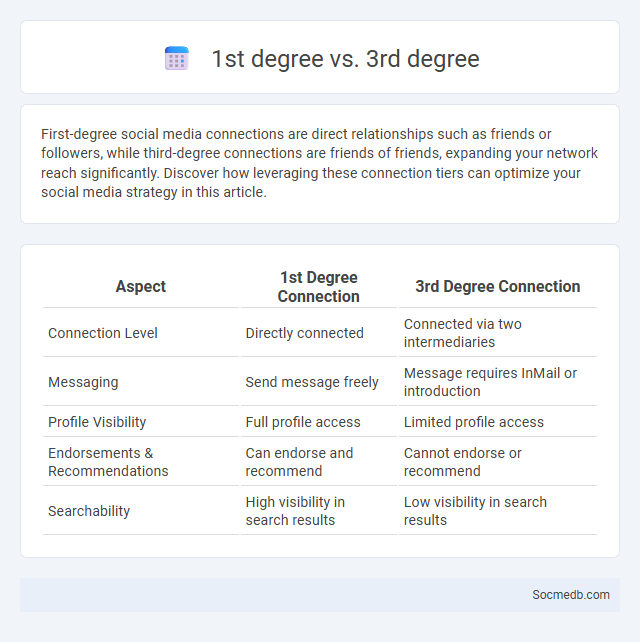
Photo illustration: 1st degree vs 3rd degree
First-degree social media connections are direct relationships such as friends or followers, while third-degree connections are friends of friends, expanding your network reach significantly. Discover how leveraging these connection tiers can optimize your social media strategy in this article.
Table of Comparison
| Aspect | 1st Degree Connection | 3rd Degree Connection |
|---|---|---|
| Connection Level | Directly connected | Connected via two intermediaries |
| Messaging | Send message freely | Message requires InMail or introduction |
| Profile Visibility | Full profile access | Limited profile access |
| Endorsements & Recommendations | Can endorse and recommend | Cannot endorse or recommend |
| Searchability | High visibility in search results | Low visibility in search results |
Understanding Degree Types: 1st, 3rd, and Connection Degree Explained
Social media platforms categorize relationships into different degree types to help users understand their network connections better. A 1st degree connection represents direct relationships, such as friends or followers, while 3rd degree connections signify individuals two or more steps removed, connected through mutual contacts. Understanding these connection degrees enhances networking strategies, improves content targeting, and expands professional or social reach.
What is a 1st Degree Connection?
A 1st Degree Connection on social media platforms like LinkedIn refers to users who are directly connected to each other, allowing seamless interaction through messages and content sharing. These connections represent mutual acceptance of connection requests, highlighting a trusted network for professional or personal engagement. Building a strong base of 1st Degree Connections enhances visibility, credibility, and opportunities within the platform's ecosystem.
Defining 3rd Degree Connections
Third-degree connections on social media platforms represent the extended network of users connected through two intermediaries, expanding your reach beyond direct friends and their immediate contacts. These connections allow your profile or content to be visible to a larger audience, increasing potential engagement and networking opportunities. Understanding and leveraging third-degree connections can significantly enhance your social media strategy by tapping into a broader community and discovering new relationships.
The Meaning of Connection Degree in Networking
Connection degree in social media networking quantifies the number of direct links or interactions an individual has within a platform, reflecting their reach and influence. A higher connection degree often correlates with enhanced information flow, increased engagement opportunities, and greater visibility in online communities. Understanding this metric helps marketers and users optimize their content strategies and build stronger, more impactful networks.
Key Differences Between 1st and 3rd Degree Connections
1st-degree connections on social media are direct contacts with whom users have mutually accepted connections, allowing full access to their profiles and direct messaging. In contrast, 3rd-degree connections represent individuals several steps removed, limiting visibility primarily to public information and often restricting direct interaction. Understanding these key differences is crucial for optimizing networking strategies and managing privacy settings effectively.
Advantages of 1st Degree Connections
First-degree connections on social media platforms offer direct access to your immediate network, enabling real-time communication and collaboration. These trusted relationships enhance your professional opportunities by facilitating personalized referrals and endorsements. Leveraging your first-degree connections increases the visibility of your content, amplifying your influence within relevant communities.
Limitations of 3rd Degree Connections
Third-degree connections on social media often lack direct interaction, resulting in weaker trust and less reliable information exchange. These distant network ties tend to reduce engagement rates and lower the accuracy of algorithm-driven recommendations. Privacy concerns also intensify as third-degree connections increase the exposure of personal data beyond familiar circles.
How Connection Degree Impacts Networking Opportunities
The degree of connection on social media platforms directly influences your networking opportunities by expanding access to industry professionals and potential collaborators. Strong connections increase the likelihood of meaningful interactions, referrals, and career growth by leveraging mutual contacts and shared interests. Enhancing your network's depth and breadth helps unlock exclusive opportunities that are often unavailable through weak or distant connections.
Expanding Your Network Across All Connection Degrees
Expanding your network across all connection degrees leverages the power of social media platforms like LinkedIn, Facebook, and Twitter to reach first, second, and third-degree connections effectively. Utilizing advanced search filters, personalized messages, and engagement strategies increases visibility and fosters meaningful relationships beyond immediate contacts. This comprehensive approach enhances professional opportunities, brand visibility, and influence in your industry.
Best Practices for Managing Connection Degrees Efficiently
Effective management of connection degrees on social media involves regularly auditing your network to maintain a relevant and engaged audience. Prioritize quality over quantity by focusing on meaningful interactions and removing inactive or irrelevant contacts. Utilizing tools for segmentation and automated workflows helps you efficiently nurture relationships, improving your overall connectivity and influence.
 socmedb.com
socmedb.com